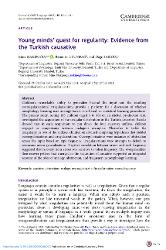| dc.contributor.author | Nakipoglu, Mine | |
| dc.contributor.author | Uzundag, Berna A. | |
| dc.contributor.author | Sarigul, Ozge | |
| dc.date.accessioned | 2023-10-19T15:11:35Z | |
| dc.date.available | 2023-10-19T15:11:35Z | |
| dc.date.issued | 2022 | |
| dc.identifier.issn | 0305-0009 | |
| dc.identifier.issn | 1469-7602 | |
| dc.identifier.uri | https://doi.org/10.1017/S0305000921000672 | |
| dc.identifier.uri | https://hdl.handle.net/20.500.12469/5102 | |
| dc.description.abstract | Children's remarkable ability to generalize beyond the input and the resulting overregularizations/ irregularizations provide a platform for a discussion of whether morphology learning uses analogy-based, rule-based, or statistical learning procedures. The present study, testing 115 children (aged 3 to 10) on an elicited production task, investigated the acquisition of the irregular distribution in the Turkish causative. Results showed that in early acquisition, to pin down the four causative suffixes, children engaged in comparisons between analogous exemplars. Thereafter to tackle the irregularity in two of the suffixes, children entertained competing hypotheses that yielded overregularizations and irregularizations. Overregularizations were instances of abstraction across the input based on type frequency; irregularizations were attempts to default to erroneous micro-generalizations. Negative correlation between errors and verb frequency suggested that recovery from errors was sensitive to token frequency. The overgeneralize-then-recover pattern that emerged in the acquisition of causative supported an integrated account of the roles of analogy, abstraction, and frequency in morphology learning. | en_US |
| dc.description.sponsorship | Bogazici University Research Fund Grant [7949] | en_US |
| dc.description.sponsorship | This work was supported by Bogazici University Research Fund Grant to Mine Nakipoglu (Grant No: 7949). Part of the present study was presented at BUCLD 35. We thank Aylin C. Kuntay for sharing the Koc University Longitudinal Language Development Database. | en_US |
| dc.language.iso | eng | en_US |
| dc.publisher | Cambridge Univ Press | en_US |
| dc.relation.ispartof | Journal of Child Language | en_US |
| dc.rights | info:eu-repo/semantics/openAccess | en_US |
| dc.subject | Logical Problem | En_Us |
| dc.subject | Language | En_Us |
| dc.subject | Rules | En_Us |
| dc.subject | Morphology | En_Us |
| dc.subject | Overregularization | En_Us |
| dc.subject | Children | En_Us |
| dc.subject | Transitivity | En_Us |
| dc.subject | Words | En_Us |
| dc.subject | causative | en_US |
| dc.subject | abstraction | en_US |
| dc.subject | analogy | en_US |
| dc.subject | overregularization | en_US |
| dc.subject | irregularization errors | en_US |
| dc.subject | frequency | en_US |
| dc.title | Young minds' quest for regularity: Evidence from the Turkish causative | en_US |
| dc.type | article | en_US |
| dc.identifier.startpage | 1214 | en_US |
| dc.identifier.endpage | 1241 | en_US |
| dc.authorid | Uzundag, Berna A/0000-0003-1192-691X | |
| dc.authorid | Nakipoglu, Mine/0000-0001-8196-1580 | |
| dc.identifier.issue | 6 | en_US |
| dc.identifier.volume | 49 | en_US |
| dc.department | N/A | en_US |
| dc.identifier.wos | WOS:000735378600001 | en_US |
| dc.identifier.doi | 10.1017/S0305000921000672 | en_US |
| dc.identifier.scopus | 2-s2.0-85118996355 | en_US |
| dc.institutionauthor | N/A | |
| dc.relation.publicationcategory | Makale - Uluslararası Hakemli Dergi - Kurum Öğretim Elemanı | en_US |
| dc.authorwosid | Uzundag, Berna A/D-1899-2019 | |
| dc.authorwosid | Nakipoglu, Mine/AAA-7427-2020 | |
| dc.khas | 20231019-WoS | en_US |
















